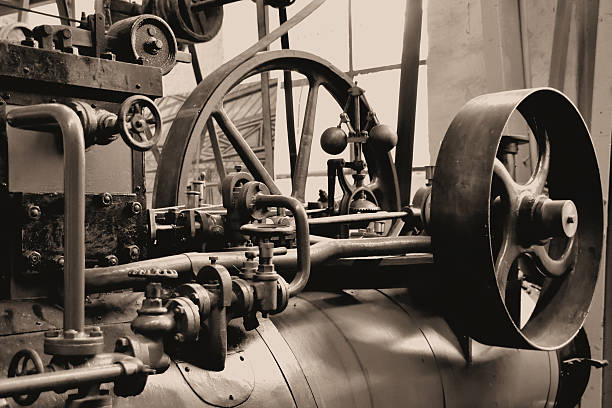How the Industrial Revolution Helped Forge a Path for Science Fiction
Posted January 1, 2024
Written by Kalyn Thompson, Heritage Square Event Coordinator
For a printable version of this article, please click here.
Did you know…
Have you ever read classic science fiction novels like Mary Shelley’s Frankenstein or perhaps flipped on the TV to the SyFy channel for a thrilling movie? Science fiction is a genre of entertainment many of us have come to know and love, but where did it come from? Interestingly enough, part of the roots of science fiction can be traced back to the Industrial Revolution – happening just before the Victorian Era.
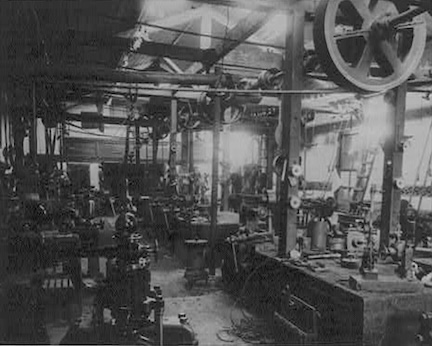
An electrical generating factory, circa 1880.
The Industrial Revolution refers to a significant period of profound societal, economic, and technological change that took place from the late 18th century to the mid-19th century. It marked a transition from primarily agrarian and handcrafted economies to industrialized and machine-driven ones. The Industrial Revolution was a massive shift in human history, marking an era of unprecedented advancement and transformation. Beyond its tangible impact on industry and infrastructure, this period served as the fertile soil from which the seeds of science fiction grew and bloomed.
The inception of science fiction as a recognizable genre can be traced back to the early 19th century. While elements of speculative fiction and fantastical storytelling existed in earlier works (see our September 2023 blog article to learn more), it wasn’t until this era that science fiction as a distinct literary genre began to take shape.
The Birth of Machines:
The rise of machinery and mechanization during the late 18th and early 19th centuries captivated the human imagination. Factories, steam engines, and automated processes reshaped daily life.
The invention of steam power, mechanization, and mass production dramatically altered the fabric of society. As people grappled with the ramifications of this technological leap, it stirred curiosity about the future and the potential consequences of unchecked progress. Research by Britannica emphasizes how this technological upheaval fueled societal transformation and sparked the human imagination, setting the stage for envisioning future worlds and technological possibilities.
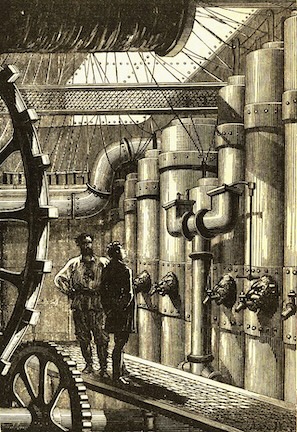
An illustration of the engines of the Nautilus submarine from 20,000 Leagues Under the Sea.
Perhaps this advancement in machinery inspired authors like Jules Verne when writing the book 20,000 Leagues Under the Sea. The story follows the thrilling underwater adventures of Professor Pierre Aronnax, his loyal servant Conseil, and Ned Land, a Canadian harpooner, as they embark on a journey aboard the submarine, Nautilus, commanded by the mysterious Captain Nemo. Submarines as we know them today were not physically in existence when this book was published in 1870, and it’s likely that the Industrial Revolution (IR) was a key component in Verne’s inspiration.
Technological Optimism and Dystopian Fears:
The dual nature of this newfound technology sparked divergent narratives in literature. Some envisioned a utopian future where machines liberated humanity from menial labor, fostering boundless creativity and leisure. However, alongside this optimistic outlook lurked a darker narrative: the fear of machines overpowering humans, leading to dystopian worlds devoid of human control.
Here are a few of examples of this in specific theme in Victorian literature:
-
- Erewhon by Samuel Butler (1872) – This satirical novel presents a fictional country where machines are banned because they are believed to have attained consciousness. It critiques various aspects of Victorian society, including the nature of morality, the limitations of technology, and the role of institutions.
- News from Nowhere by William Morris (1890) – In this utopian/dystopian novel, the protagonist wakes up in a future society that appears ideal but, upon closer examination, reveals its flaws. The story questions societal progress, the impact of industrialization, and the possibility of creating a truly perfect society.
- The Time Machine by H.G. Wells (1895) – H.G. Wells’ novel explores a future world where society has evolved into two distinct species: the Eloi, who live a life of leisure and luxury, and the Morlocks, who dwell underground and maintain the machinery that supports the Eloi. The story serves as a commentary on class division and the potential consequences of societal evolution.
While these Victorian-era novels may not fit the modern classification of dystopian literature as we understand it today, they offer glimpses into speculative and critical examinations of societal structures, technological advancements, and the human condition. These works laid a foundation for the development of dystopian themes in literature in the following centuries.
Innovations and Imagination:
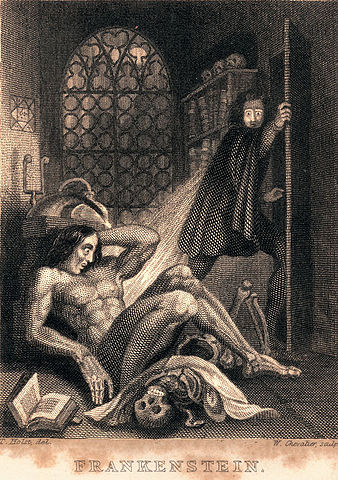
An engraving from the 1831 edition of Frankenstein: A Modern Prometheus.
Authors of the time tapped into societal anxieties surrounding unchecked scientific progress. In Frankenstein, Mary Shelley’s cautionary tale echoed concerns about the ethical boundaries of scientific experimentation and the potential consequences of “playing God.”
Both Shelley’s classic and works such as H.G. Wells. The Time Machine explore the varying ethical and moral dilemmas and the imagined possibilities of their time. The New York Public Library’s blog explores how these literary works grappled with the consequences of scientific experimentation and the societal implications of technological advancements.
Exploring Uncharted Realms:
The Industrial Revolution expanded global horizons, fostering exploration and discovery. These adventuresome exploits inspired narratives centered on space travel, exploring new worlds, and encountering alien species. Other novels by author Jules Verne (From the Earth to the Moon and its sequel, Around the Moon) envisioned fantastical voyages to the moon, setting the stage for what would become some of the core elements of science fiction.
Social Commentary and Technological Speculation:
Science fiction became a vessel for commentary on societal issues. Writers used futuristic settings to critique the flaws of their own era. Themes of inequality, social injustice, and the ethical dilemmas of technological advancement became woven into the fabric of the genre.
The burgeoning technological landscape found its reflection in literature, giving birth to narratives that explored the promises and perils of unchecked progress. The relationship between the Industrial Revolution and literature sheds light on how authors of the time grappled with the impact of machinery on human existence, laying the groundwork for the themes that would become quintessential to science fiction.
The Legacy of Industrial Revolution in Science Fiction:
The Industrial Revolution stands as a watershed moment in human history, fostering an era of groundbreaking technological advancements that not only reshaped society but also sowed the seeds for an entirely new genre of literature: science fiction.
The impact of the Industrial Revolution on science fiction remains immeasurable. Its legacy continues to shape our contemporary understanding of the genre, inspiring tales of futuristic societies, advanced technology, and the intricate dance between humanity and innovation. Through the lens of technological progress and societal change, authors crafted narratives that challenged, intrigued, and captivated audiences, ultimately birthing a genre that continues to evolve and thrive in the modern era.
The links between the Industrial Revolution and science fiction offer a rich tapestry of exploration and speculation, illuminating the profound impact of historical change on the creative minds that envisioned our future. As we continue to navigate our own technological revolution, it’s essential to reflect on the lessons embedded within these early science fiction tales, for they serve as cautionary reminders and guiding lights into the uncharted territories of tomorrow.
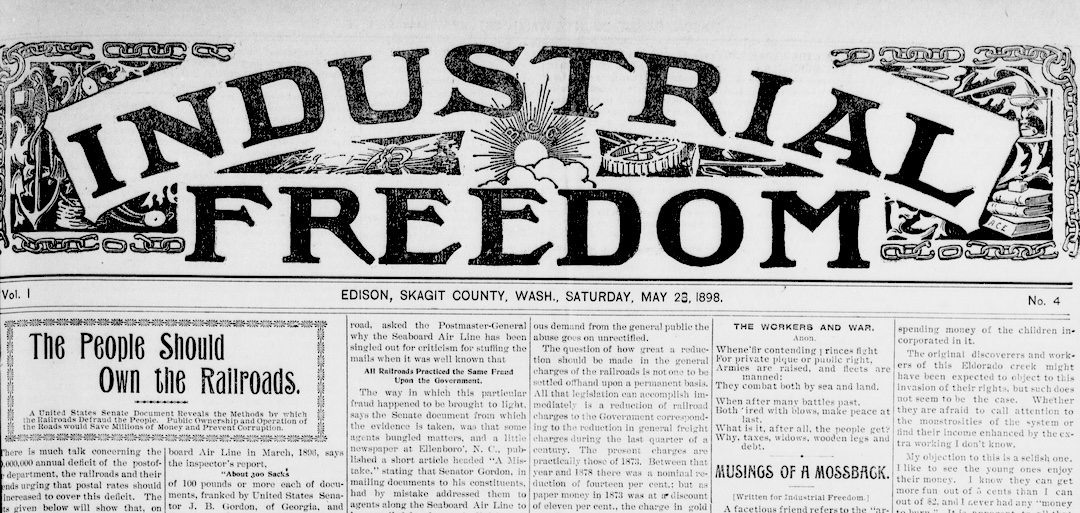
Information for this article was found online through the Library of Congress archives, Smithsonian libraries, Britannica, and Biography. Photographs were sourced from the Library of Congress.
Archive
-
2024
-
July (1)
-
June (1)
-
May (1)
-
April (1)
-
March (1)
-
February (1)
-
January (1)
-
-
2023
-
December (1)
-
November (1)
-
October (1)
-
September (1)
-
August (1)
-
July (1)
-
June (1)
-
May (1)
-
April (1)
-
March (1)
-
February (1)
-
January (1)
-
-
2022
-
December (1)
-
November (1)
-
October (1)
-
September (1)
-
August (1)
-
July (1)
-
June (1)
-
May (1)
-
April (1)
-
-
2021
-
December (1)
-
November (1)
-
October (1)
-
September (1)
-
August (1)
-
July (1)
-
June (1)
-
May (1)
-
April (1)
-
March (1)
-
February (1)
-
January (1)
-
-
2020
-
December (1)
-
November (1)
-
October (1)
-
September (1)
-
August (1)
-
July (1)
-
June (1)
-
May (1)
-
April (1)
-
March (1)
-
February (1)
-
January (1)
-
-
2019
-
December (1)
-
November (1)
-
October (1)
-
September (1)
-
August (1)
-
July (1)
-
June (1)
-
May (1)
-
April (1)
-
March (1)
-
February (1)
-
January (1)
-
-
2018
-
December (1)
-
November (1)
-
October (1)
-
September (1)
-
August (1)
-
July (1)
-
May (1)
-
April (1)
-
March (1)
-
February (1)
-
January (1)
-
-
2017
-
December (1)
-
November (1)
-
October (1)
-
September (1)
-
August (1)
-
July (1)
-
June (1)
-
May (1)
-
April (1)
-
March (1)
-
February (1)
-
January (1)
-
-
2016
-
December (1)
-
-
2015
-
2014
-
July (1)
-
